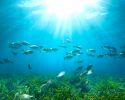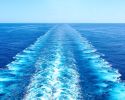Lighthouse external analysis 2025 – Uncertainty and tariffs shape the maritime industry

Donald Trump took office in the White House, launched trade wars, and challenged the IMO’s tougher climate regulations. With escalating geopolitical tensions, the world and the maritime sector now face an “uncertainty dilemma” that threatens both globalization and the transition to climate neutrality. That is the key message in Lighthouse’s Global Analysis for 2025.
Summary
Lighthouse’s new analysis describes a 2025 marked by geopolitical tension and economic volatility across the entire transport sector. The wars in Ukraine and the Middle East, along with Houthi rebel attacks in the Red Sea, have forced vessels to avoid the Suez Canal — a detour that can extend voyages by up to three weeks and drive fuel costs sharply higher.
At the same time, the green transition is slowing down. The EU’s FuelEU Maritime package and the IMO’s planned Net-Zero Framework are intended to push down emissions in the long run, but U.S. resistance and unclear regulations have made many shipping companies hesitant to invest. A recent research report refers to an “uncertainty dilemma” where climate goals and trade policy pull in opposite directions.
Nevertheless, development has not come to a halt. Orders for vessels powered by alternative fuels hit record levels in 2024, and methanol and ammonia have moved from pilot projects to commercial use. Interest is also growing in biofuels, wind-assist technologies, and carbon capture, while nuclear power is increasingly being discussed as a potential long-term solution for the largest vessels.
However, according to DNV, orders for vessels powered by alternative fuels decreased by 48% in the first nine months of 2025 compared to the same period last year. So far, 192 vessels have been ordered — 121 LNG-powered and 43 methanol-powered. The decline has been most pronounced in the third quarter, which DNV attributes to uncertainties surrounding the IMO’s Net-Zero Framework and future fuel availability.
Interest in maritime research is also growing. In April, the European Commission’s Joint Research Centre (JRC) released a report showing that nearly one billion euros have been invested over the past five years in research and innovation to reduce carbon emissions from European shipping. These funds have supported 151 projects, most of them under the Horizon 2020 and Horizon Europe programs.
In Sweden, it is also clear that the future of shipping depends on innovation and long-term investment. The new National Agenda for Maritime Research and Innovation (NRIA Shipping 2025) urges the government to double research funding over the next three years and to earmark revenues from the shipping sector’s payments into the EU Emissions Trading System (EU ETS) for reinvestment in the industry’s green transition.
Several regulatory changes have also taken place in Sweden during 2025.
As of 1 July 2025, discharges from open-loop scrubbers are prohibited in Swedish territorial waters. On the same date, a controversial cost for shipowners was removed when the 0.4% stamp duty on mortgage registration in the Swedish ship registry was abolished.
Also on 1 July, a new regulation came into force allowing intensified control of ships’ insurance documents, aiming to tackle issues related to the Russian “shadow fleet” and thereby improve maritime safety and environmental protection.
For more details, see the full 13-page report (in swedish).
-
 Sociala relationer påverkar val av bränsle
Sociala relationer påverkar val av bränsle -
 Sjöfartens omställning kräver ”mjukare” påtryckningar
Sjöfartens omställning kräver ”mjukare” påtryckningar -
 Hon hade avtalad tid med Kapten ynkrygg
Hon hade avtalad tid med Kapten ynkrygg -
 Lighthouse omvärldsanalys 2025 – osäkerhet och tullar präglar sjöfarten
Lighthouse omvärldsanalys 2025 – osäkerhet och tullar präglar sjöfarten -
 Se seminariet Shipping in the Marine Environment
Se seminariet Shipping in the Marine Environment -
 Vad betyder egentligen de 90 procenten?
Vad betyder egentligen de 90 procenten? -
 Hålla där...
Hålla där... -
 Ny rapport: Klimatförändringarna ett hot mot de flesta större hamnar i världen
Ny rapport: Klimatförändringarna ett hot mot de flesta större hamnar i världen -
 Nytt AI-verktyg tar lasthanteringen till nästa nivå
Nytt AI-verktyg tar lasthanteringen till nästa nivå -
 Ammoniak tar kliv mot att bli ett framtida sjöfartsbränsle
Ammoniak tar kliv mot att bli ett framtida sjöfartsbränsle

